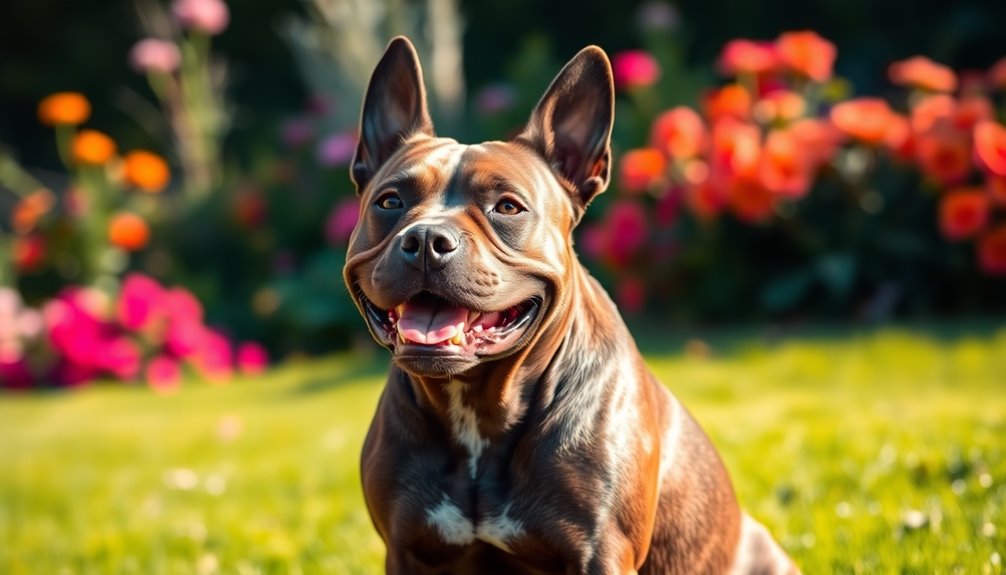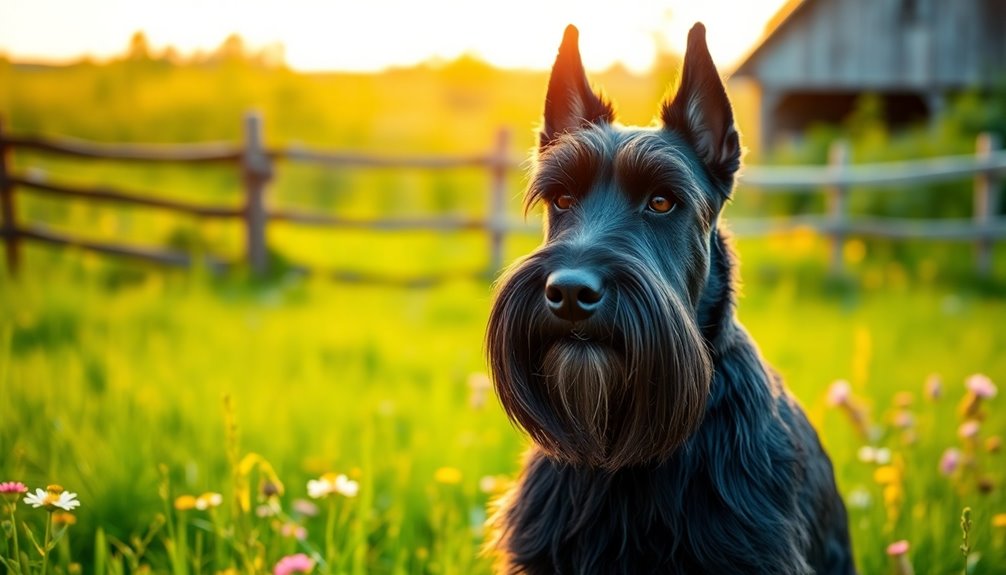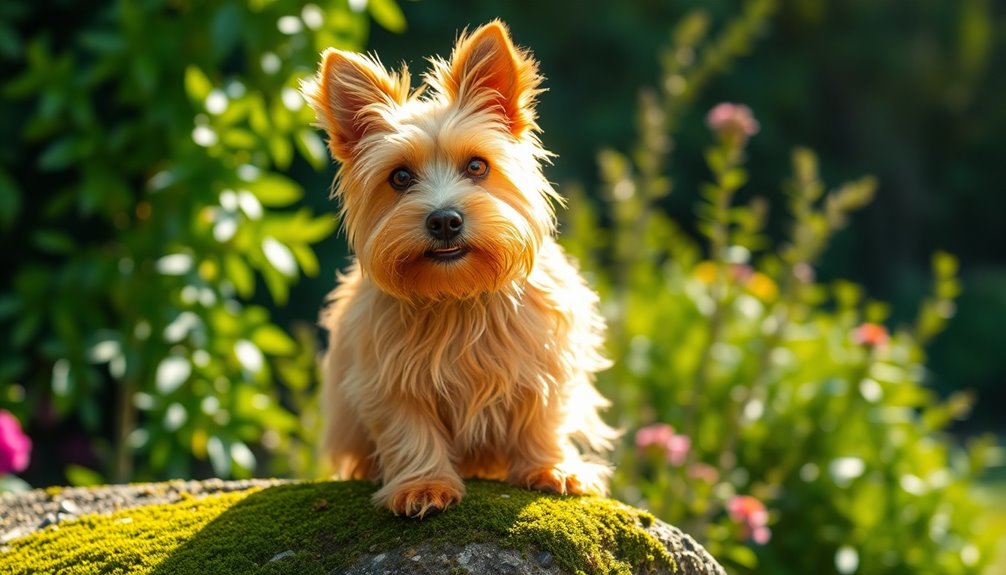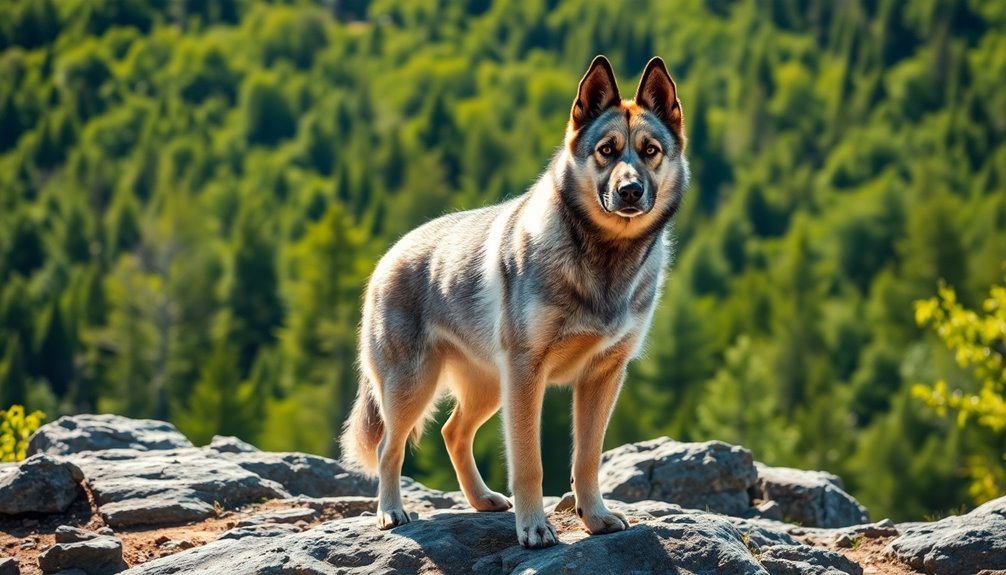The Staffordshire Bull Terrier is a loyal and affectionate breed, perfect for families. Standing at 14-16 inches tall and weighing between 29-37 pounds, they're known for their muscular build and playful nature. These dogs thrive on companionship and are often called "nanny dogs" for their gentle demeanor with children. With a courageous spirit, they require regular exercise and mental engagement to stay happy. Their short coat needs minimal grooming, making them great companions for active families. If you want to discover more about their care, training, and ideal living environments, just keep exploring this wonderful breed.
Key Takeaways
- Staffordshire Bull Terriers are known for their loyalty and affectionate nature, earning them the nickname "nanny dogs" for their bond with children.
- They have a muscular build, standing 14-16 inches tall and weighing 29-37 pounds, showcasing strength and courage.
- This breed requires 1 to 2 hours of daily exercise to maintain their physical and mental well-being, preventing boredom and destructive behaviors.
- Early socialization and training with positive reinforcement are essential for balancing their protective instincts with friendliness towards others.
- Staffordshire Bull Terriers typically live 12 to 14 years and benefit from regular veterinary check-ups to monitor common health concerns.
Introduction
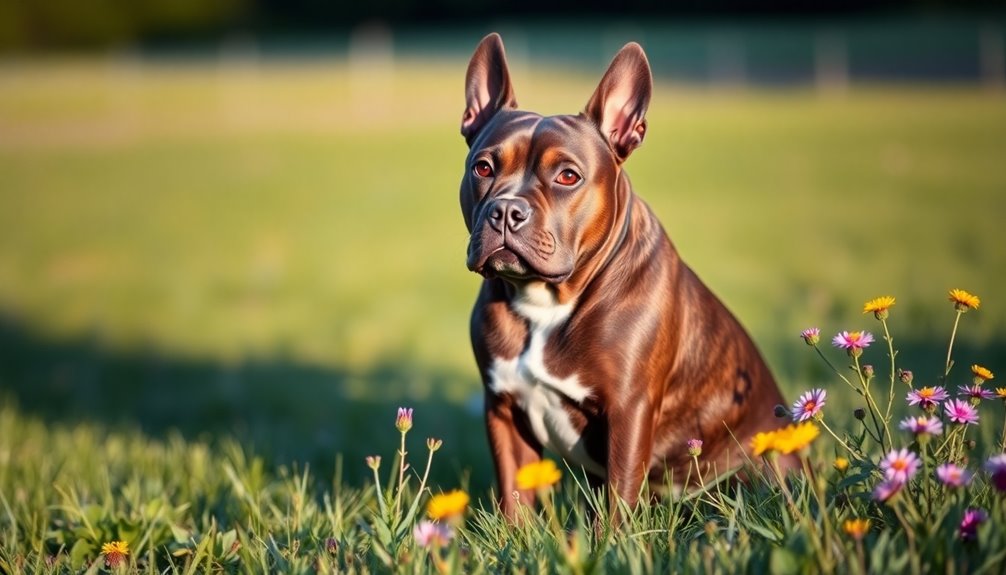
Introducing the Staffordshire Bull Terrier, you'll quickly discover a breed renowned for its affectionate nature and impressive strength. Standing at 14 to 16 inches and weighing between 29 to 37 pounds, these dogs boast a muscular build, broad head, and pronounced cheek muscles. Their short, stiff coats come in a variety of colors, including fawn, blue, and brindle, making them visually striking.
These dogs aren't just about looks; they're incredibly loyal and protective, making them excellent family companions and guard dogs. Their affectionate demeanor, especially with children, earns them the title of "nanny dogs" in England. The breed is also recognized for its high intelligence, which contributes to their trainability and responsiveness to positive reinforcement.
With a courageous and bold personality, Staffordshire Bull Terriers thrive on interaction and play, requiring regular exercise and mental stimulation to keep boredom at bay.
While they're generally gentle, they can be a bit challenging around other dogs, so early socialization is essential. Training them is a rewarding experience, as they respond well to positive, game-based methods.
With their medium-length tail and low grooming needs, these dogs adapt well to various living arrangements, making them perfect for different lifestyles.
History and Origin

The Staffordshire Bull Terrier has its roots in the mid-16th century, tracing back to Mastiff-like dogs and old Bulldogs used in bear- and bull-baiting. These dogs were highly valued for their bravery and were later crossed with British terriers to create the first Bull and Terriers. As you learn more about their history, you'll see how their early roles in baiting and farm protection shaped the breed we know today. Post outlawing of baiting, the focus shifted to dog fighting and creating a sporting dog.
Where and when the breed originated
Originating in England during the 19th century, the Staffordshire Bull Terrier has a rich history shaped by its ancestors, including old English Bulldogs and various British terriers.
Initially known as "Bull and Terriers," these dogs were bred by crossing old English Bulldogs with Manchester Terriers and the English White Terrier. The goal was to combine the bulldog's courage with the agility of terriers, creating a versatile breed fit for various tasks.
By 1900, two distinct types of Bull and Terrier emerged: the Staffordshire Bull Terrier and the Bull Terrier. While the latter often underwent further refinement through crosses with modern Bulldogs and other breeds, the Staffordshire Bull Terrier remained closely associated with the working class. This connection to the working class is evident in the breed's cultural significance in areas like the Black Country, where they were valued for their loyalty and gameness.
Despite their early roles in bloodsports, these dogs were cherished as family companions.
The breed gained formal recognition from the English Kennel Club in 1935, with dedicated clubs forming to celebrate their unique qualities.
Notably, the Staffordshire Bull Terrier's evolution reflects a transition from fighting dog to beloved family pet, showcasing their loyalty, affection, and courage, which you can see in their modern character today.
Bull-Baiting and Farm Protection
Bull-baiting played a significant role in the early development of the Staffordshire Bull Terrier, showcasing the breed's strength and tenacity. This brutal sport involved dogs attacking a tethered bull, primarily for entertainment and to tenderize the meat. Alongside bull-baiting, other blood sports like bear-baiting and cockfighting thrived, attracting both royalty and commoners until they were outlawed. The goal was to test dogs' gameness, skill, and endurance, laying the foundation for the Staffordshire Bull Terrier.
After the 1835 ban on bull and bear baiting, dog fighting emerged as a clandestine alternative, especially in working-class areas. It allowed for easier organization and concealed competition, focusing on dogs' qualities like bravery and toughness. Breeders began selecting for specific traits, ensuring that these dogs were resilient yet trustworthy around humans, creating a balance that would shape the modern breed's reputation for loyalty and trustworthiness.
Despite its rocky beginnings, the Staffordshire Bull Terrier evolved into a loving companion. Legal reforms in the early 20th century further shifted perceptions, leading to the breed's formal recognition and preservation efforts that highlighted their affectionate nature while minimizing aggression towards humans.
Physical Characteristics
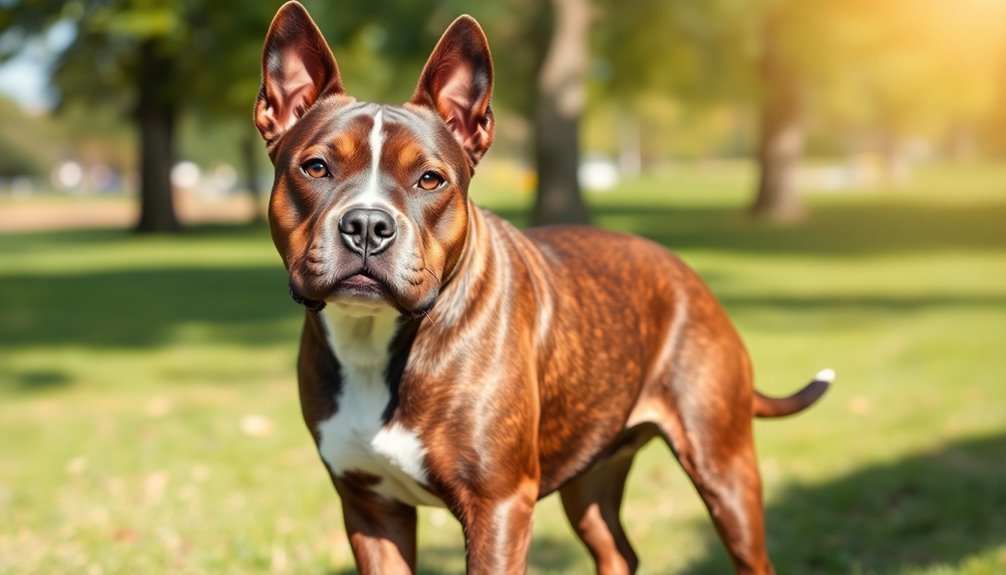
When you look at a Staffordshire Bull Terrier, you'll notice their compact size and muscular build, making them both strong and agile. Males typically weigh between 13 to 17 kg, while females range from 11 to 15.4 kg, and their broad heads give them a distinctive appearance. With a smooth, short coat in various colors, they not only look impressive but also showcase a well-defined structure that complements their lively personality. Growth monitoring is important for assessing their health, ensuring they maintain an optimal weight as they develop.
Size, weight, and coat details
The Staffordshire Bull Terrier is a medium-sized dog known for its muscular build and athletic prowess. Typically, these dogs measure between 14 to 16 inches at the shoulder, with males usually being taller than females. They reach their adult height by around 12 to 18 months, though individual factors may cause slight variations.
When it comes to weight, the optimal range for this breed is between 11 to 17 kg (24 to 37 lbs). Females generally weigh between 11 to 15 kg (24 to 33 lbs), while males tend to be heavier, ranging from 13 to 17 kg (29 to 37 lbs). It's important to monitor their weight, as it can fluctuate based on size, age, and activity level. Maintaining a healthy weight is essential for their longevity and overall health.
The coat of a Staffordshire Bull Terrier is short and smooth, coming in various colors such as red, fawn, white, black, blue, or brindle, with or without white markings. The coat is stiff and not hypoallergenic, so if you're sensitive to pet dander, this breed mightn't be the best fit for you.
Muscular Build and Broad Head
With their powerful physique, Staffordshire Bull Terriers are instantly recognizable for their muscular build and broad head. This breed features a short, broad head with prominent cheek muscles and a wide jaw that gives them a distinctive look. Their strong shoulders and broad chest naturally support their athleticism, allowing them to excel in various physical activities.
To maintain this muscular build, focus on a high-protein diet, ensuring about 30% of their calories come from protein and around 25% from fat. Minimize carbohydrates, as these aren't essential for muscle building. Supplements like omega fatty acids and glucosamine can promote joint health, enhancing their physical capabilities. It is also important to ensure regular rest days to allow for muscle recovery and growth.
Exercise is crucial for Staffordshire Bull Terriers. Start strength training only after 18 months, gradually increasing intensity with proper equipment. Regular activities like swimming, running, and weight pulling build muscle and stamina effectively.
Don't forget rest days for recovery to prevent injury. Their wide-set legs contribute to their stable stance, and their short, stiff coat showcases their impressive muscle definition.
With the right diet and exercise regime, your Staffordshire Bull Terrier will thrive in both strength and agility.
Temperament and Personality
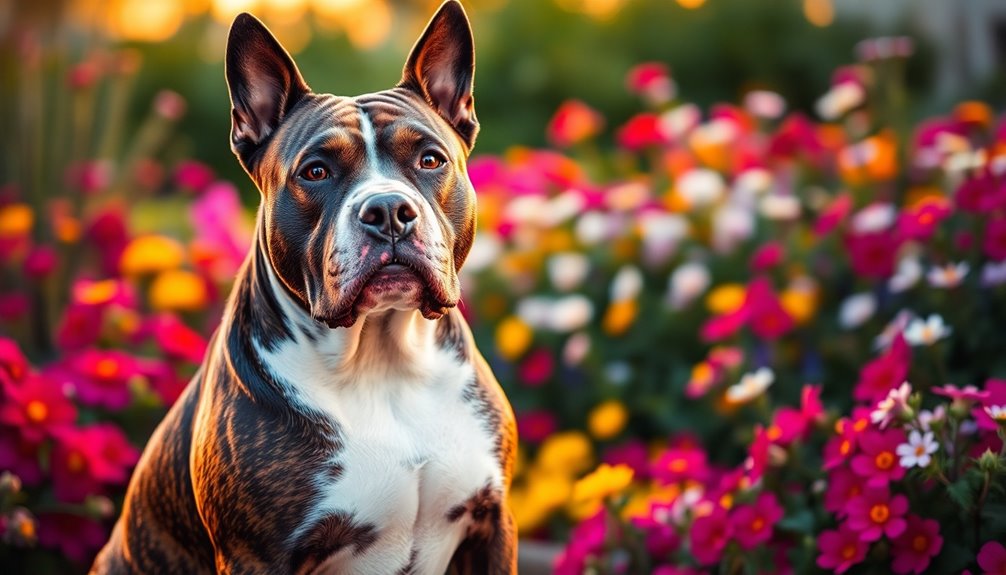
When you think about the Staffordshire Bull Terrier, their playful and protective nature stands out. These dogs make excellent companions for families and individuals alike, adapting well to various living situations. However, if you have other pets, it's important to consider their strong prey drive and ensure proper socialization. To maintain a happy and well-adjusted pet, they require proper physical and mental stimulation to thrive.
Playful and Protective Nature
Known for their vibrant personalities, Staffordshire Bull Terriers embody a playful and protective nature that makes them beloved companions. They're affectionate and fun-loving, always eager for games and human interaction.
With their high energy levels, these dogs thrive on regular exercise and mental stimulation, ensuring they remain well-behaved and happy. Their intelligence allows for easy training, making it simple for you to teach them tricks and engage in various activities. Regular exercise is essential to their well-being, as it helps prevent behavioral issues linked to obesity in Staffordshire Bull Terriers.
On the protective side, Staffordshire Bull Terriers have a natural guarding instinct stemming from their original breeding. They're fiercely loyal and devoted to their families, often positioning themselves between loved ones and perceived threats.
Their alertness and speed make them excellent watchdogs, while their strong bite force requires responsible ownership and proper training.
Socialization plays a crucial role in balancing their protective instincts, ensuring they're friendly rather than aggressive towards unfamiliar individuals.
With a strong emotional bond to their families, these dogs can experience separation anxiety if left alone too long. By understanding their playful and protective nature, you can cultivate a loving and secure environment for your Staffordshire Bull Terrier.
Suitability for families, individuals, or other pets
Staffordshire Bull Terriers are excellent companions for families, individuals, and even other pets when properly socialized. Their patient and tolerant temperament makes them ideal for families, earning them the affectionate nickname "nanny dog." They thrive on attention and love being involved in family activities, but supervision is essential around very young children due to their playful nature.
For active individuals, Staffies fit well into your lifestyle, as they require regular exercise and stimulation. They can adapt to various living situations, whether urban or rural, but need a stable environment filled with social interaction. Their average lifespan of 12 to 14 years is a testament to their resilience when properly cared for.
Consistent training and positive reinforcement are crucial in managing their energetic spirit and potential stubbornness.
When it comes to other pets, caution is necessary. While they can coexist with other dogs if socialized early, they may be better suited for single-pet households due to their strong prey drive. Small pets like cats or rabbits mightn't be safe around them without careful introductions.
With the right training and supervision, Staffordshire Bull Terriers can harmoniously integrate into homes with various family dynamics.
Health and Lifespan
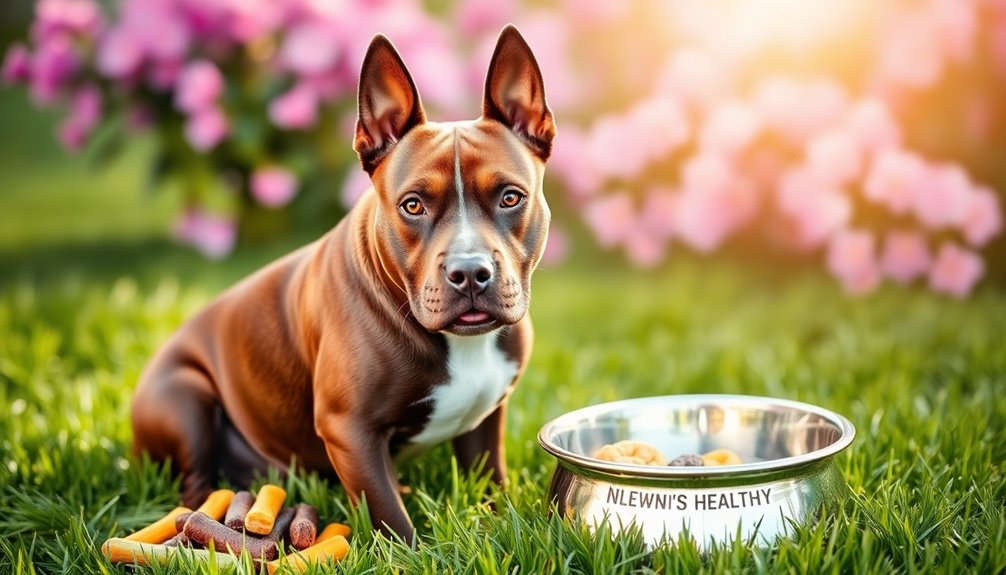
When it comes to the health and lifespan of Staffordshire Bull Terriers, you'll want to be aware of their typical life expectancy and common health issues they may face. These dogs often live between 12 to 14 years, but certain genetic predispositions can affect their overall wellness. Regular veterinary check-ups are essential to monitor for common health issues that may arise.
Typical lifespan of the breed
The typical lifespan of a Staffordshire Bull Terrier ranges from 12 to 14 years, although various factors can influence this expectancy. A 2022 UK study noted an average life expectancy of about 11.33 years, while a 2024 study reported it at 12 years. Genetics, level of care, and environmental conditions all play significant roles in determining how long your dog will live.
To help your Staffordshire Bull Terrier reach the upper end of this lifespan range, focus on proper healthcare and management. Regular veterinary check-ups are crucial for early diagnosis and treatment of potential health issues, as routine check-ups can help monitor and address any health concerns promptly.
Additionally, maintaining a balanced diet tailored to your dog's age, size, and activity level is essential. Make sure your dog gets at least an hour of exercise daily and provide plenty of mental stimulation and emotional bonding.
Avoid foods high in fillers and artificial additives, and adjust portion sizes based on your dog's needs. By prioritizing these factors, you can contribute to a healthier, happier life for your Staffordshire Bull Terrier, ultimately enhancing their longevity and quality of life.
Common health concerns or genetic predispositions
While every dog is unique, Staffordshire Bull Terriers are prone to several common health concerns and genetic predispositions that can impact their overall well-being.
One major issue is hip dysplasia, a hereditary condition that can lead to arthritis, abnormal walking, and weakness in the hind legs. Additionally, L-2-Hydroxyglutaric Aciduria (L2HGA) is a neurometabolic disorder that often surfaces between six months and a year, causing seizures and muscular cramps.
Eye disorders like cataracts and Persistent Hyperplastic Primary Vitreous (PHPV) can affect vision, resulting in cloudy pupils and impaired distance judgment. Regular veterinary check-ups are vital for detecting early health issues related to these eye conditions.
Furthermore, degenerative myelopathy, an inherited neurologic disorder, can lead to muscle atrophy and loss of coordination, usually starting around nine years of age.
Staffies may also face orthopedic issues due to their muscular build, increasing the risk for joint problems like elbow dysplasia and cruciate ligament injuries.
Skin conditions, particularly allergies, are common, especially in dogs with a blue coat.
Lastly, Staffordshire Bull Terriers can be susceptible to heart conditions and obesity, making regular health screenings and proper care essential for maintaining their health.
Tips for maintaining health and wellness
Maintaining the health and wellness of your Staffordshire Bull Terrier is essential for a long, happy life together. Start by scheduling regular veterinary check-ups. These visits help catch potential health issues early, so don't skip vaccinations, dental cleanings, and parasite prevention. If you're considering breeding, genetic testing can identify health concerns beforehand.
Next, focus on providing a balanced diet tailored to your dog's age, weight, and activity level. Ensure their meals are rich in proteins, fats, carbohydrates, vitamins, and minerals, and avoid foods with excessive fillers or artificial additives. Including omega-3 and omega-6 fatty acids can boost their skin and coat health, while weight management can help reduce joint stress. Additionally, feeding your dog high-quality ingredients can support their overall health and vitality.
Exercise is another key component. Aim for at least two walks a day, each lasting about 30 minutes, and incorporate playtime for mental stimulation. Activities like swimming can help with joint health, too.
Lastly, don't underestimate the importance of grooming and socialization. Regular grooming allows you to check for unusual lumps and maintain a healthy coat. Engaging in training sessions with positive reinforcement won't only keep their minds sharp but also strengthen your bond.
Care Requirements
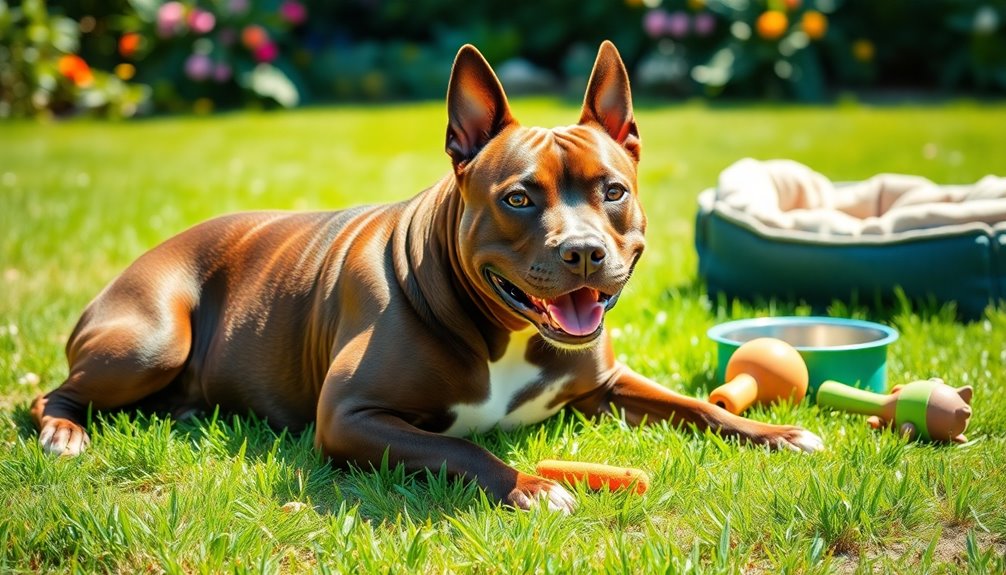
Caring for a Staffordshire Bull Terrier involves understanding their exercise needs, grooming habits, and dietary requirements.
With minimal shedding and easy grooming, these dogs thrive on regular physical activity and mental stimulation. To keep them physically fit, it's important to meet their daily exercise requirements to prevent destructive behavior and health issues.
It's essential to provide a balanced diet suited to their energy levels to keep them healthy and happy.
Minimal Shedding, Easy Grooming
Grooming your Staffordshire Bull Terrier is a straightforward task, thanks to their short, smooth coat that requires minimal upkeep. While they shed moderately year-round, you'll notice an increase in shedding during autumn and spring. Regular brushing, at least once a week, is key to managing this shedding and keeping their coat healthy and shiny. Use a bristle brush, rubber curry brush, or grooming mitt to distribute natural oils and strengthen your bond with your pup.
During shedding seasons, a specialized tool like a Furminator can be particularly effective. Be gentle while brushing to avoid irritating their skin, as the short coat has little fur to buffer your brush. Additionally, be mindful that their vulnerable skin may require extra protection from the sun due to their short coat.
You won't need to bathe your Staffordshire Bull Terrier often; every 6-8 weeks or when they get dirty is sufficient. Stick to mild, dog-friendly shampoos to maintain their skin's natural properties. Don't forget about other grooming needs! Trim their nails every 3-4 weeks, check their ears weekly for cleanliness, and maintain daily dental care to keep them healthy.
Exercise requirements and energy levels
Along with their grooming needs, Staffordshire Bull Terriers require a solid exercise routine to keep them happy and healthy.
You'll need to provide at least 1 to 2 hours of exercise each day, mixing physical activities with mental stimulation. Daily walks of 30 to 45 minutes are essential, but you can also engage your Staffie in brisk running, tug-of-war, or fetch to burn off energy. Regular exercise caters to their working breed heritage, making it crucial for their overall well-being.
Consider incorporating dog sports like agility or flyball for an extra challenge.
Make sure to spread their exercise throughout the day to avoid overexertion and focus on activities that promote socialization, like playdates with other dogs.
Remember, mental stimulation is just as important as physical activity. Puzzle toys, scent work, and training sessions keep their minds engaged and help prevent boredom and destructive behaviors.
Take your dog's age and health into account when planning their exercise. Puppies need shorter play sessions, while adult Staffies can handle more vigorous activities.
For seniors, reduce the intensity to match their energy levels. Always consult with your vet for personalized exercise recommendations to ensure your furry friend stays fit and healthy.
Feeding tips and diet recommendations
Feeding your Staffordshire Bull Terrier a balanced diet is crucial for their overall health and vitality. Start with high-quality protein to support muscle health and body functions. Include balanced fats, like omega-3 and omega-6 fatty acids, to boost energy and maintain skin and coat condition. Additionally, specific vitamins and minerals are crucial for joint health and overall wellness.
Carbohydrates from brown rice, sweet potatoes, and oats provide sustained energy and essential fiber. Don't forget vitamins and minerals for immune support, bone health, and metabolic processes.
For feeding schedules, adults should eat twice a day, while puppies need three to four meals until around nine months. Portion control is key to prevent obesity, so adjust portions based on age, weight, and activity level. Generally, an adult's daily intake is 1.5 to 2.5 cups of dry food or 850-1100 calories.
Consider special dietary needs; puppies require nutrient-rich formulas, while adults might benefit from supplements like glucosamine or omega-3s. Opt for high-quality dog food with real meat as the first ingredient.
Dry kibble can aid dental health, while wet food is often more appealing. Always choose foods approved by the AAFCO to ensure nutritional standards are met.
Training and Socialization
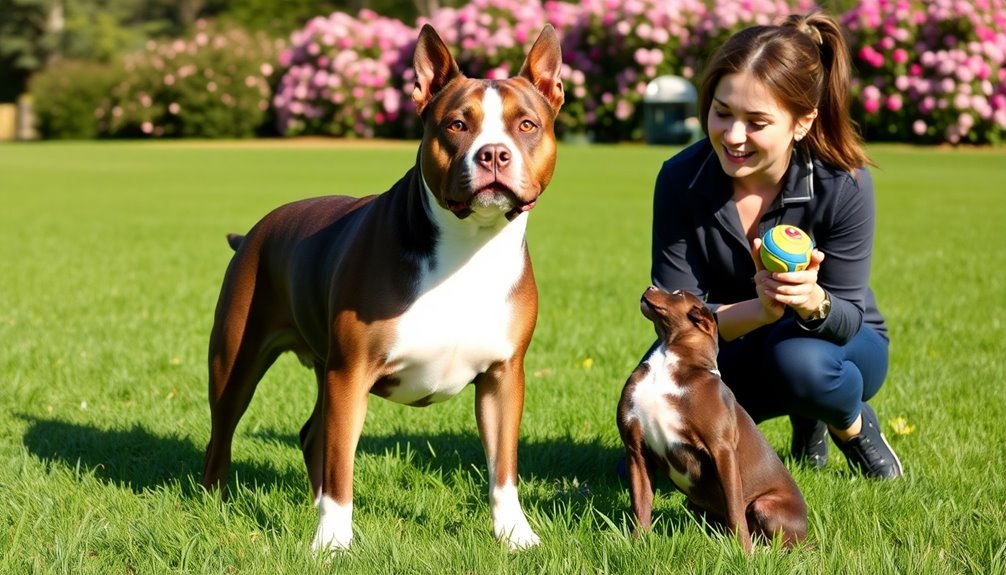
When training your Staffordshire Bull Terrier, you'll appreciate their intelligence and eagerness to learn, so take advantage of that enthusiasm. Gradually introducing them to new environments helps build their confidence and reduces anxiety. You'll also want to focus on leash reactivity and impulse control to ensure they behave well in various situations. Consistent training and clear expectations will enhance the communication between owner and puppy.
Highly Intelligent and Eager
Training a Staffordshire Bull Terrier can be a rewarding experience due to their highly intelligent nature and eagerness to learn. These dogs adapt quickly to commands and are always eager to perform, making them highly trainable. Their sharp minds and problem-solving abilities shine through when you provide mental stimulation, preventing boredom and unwanted behaviors.
Using positive reinforcement techniques like treats, praise, and interactive play will yield the best results. Stick to clear, simple commands such as "sit," "stay," and "come" for effective training. Keep training sessions short and engaging—10 to 15 minutes is ideal. Consistency in your approach and expectations is crucial, so establish a routine that you can maintain. It's also important to note that some breeds like Staffordshire Bull Terriers exhibit natural protective instincts, adding another layer to their training potential.
Be prepared for some initial challenges, as Staffordshire Bull Terriers can be a bit stubborn. Patience is key; they may not grasp new commands immediately. Instead of punishment, focus on redirecting unwanted behaviors toward positive alternatives.
Remember to celebrate small milestones, as setting realistic expectations will keep you motivated. With the right approach, your Staffordshire Bull Terrier can become a well-trained companion, showcasing their intelligence and eagerness to learn.
Gradual Introductions to New Environments
Gradually introducing your Staffordshire Bull Terrier to new environments is essential for their development and socialization. Start with familiar places like your home and backyard. Introduce small changes, such as new toys or blankets, to help your dog adapt to minor alterations. Playing calming music can also ease their nerves during these introductions. Reward calm behavior with treats and praise, and allow your dog to explore at their own pace.
Once your dog adjusts to smaller changes, gradually expose them to new stimuli. Start with low-intensity experiences and monitor their body language for signs of stress. Adjust the intensity based on their comfort level, and always use positive reinforcement techniques to create good associations. Early and ongoing socialization is vital for developing well-adjusted behavior in adulthood. It's important to remember that just like miniature horses, consistent exposure and positive reinforcement can greatly enhance your dog's adaptability to new situations.
Arrange controlled interactions with well-behaved dogs and friendly people, supervising closely to ensure positive experiences. Introduce your dog to a variety of people to prevent biases.
Building confidence is crucial, so begin in quieter areas of new environments, using familiar toys and games to engage them. Keep initial visits short and gradually extend their duration as your dog becomes more comfortable. Retreat to quieter spots if they show signs of discomfort.
Leash Reactivity and Impulse Control
Leash reactivity can be a frustrating challenge for many Staffordshire Bull Terrier owners, often leading to unwanted behaviors like barking or lunging toward other dogs. This reactivity usually stems from fear, frustration, or insufficient socialization. Understanding your dog's triggers is crucial for effective training. Incorporating educational toys into playtime can also help alleviate excess energy and promote a calmer demeanor.
Start by gradually exposing your dog to other dogs at a safe distance, allowing them to maintain calmness. Pair these encounters with positive experiences, such as treats and praise, to foster positive associations. Reward calm behavior consistently to reinforce the desired response. Additionally, be aware that fear reactivity can often escalate if the dog feels cornered or threatened.
Incorporate obedience training exercises like loose leash walking and attention drills. Use positive reinforcement methods to promote calm walking on the leash. Practice impulse control in everyday situations, like waiting at doorways or before receiving treats.
Socialize your dog from an early age with various environments, people, and animals. Group training classes can enhance structured learning and socialization.
Keep the training environment stimulating and engaging to channel your dog's energy positively. With patience and consistency, you'll help your Staffordshire Bull Terrier develop better leash manners and impulse control.
Ideal Living Environment
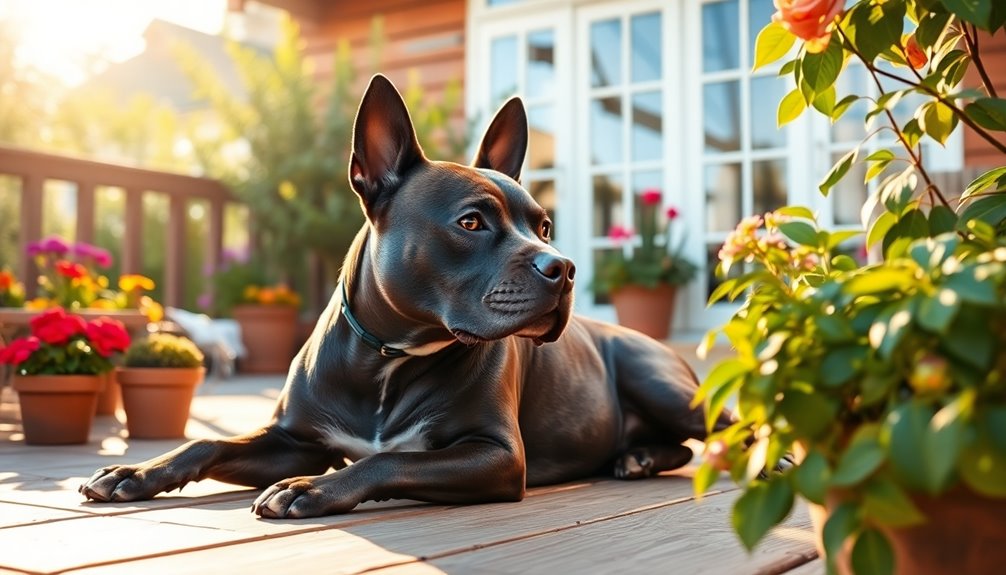
To keep your Staffordshire Bull Terrier happy and healthy, a spacious backyard is essential for their daily exercise. They thrive in various climates, but you need to be mindful of their heat sensitivity, especially during the hotter months. Ensuring they've ample space to play and cool down will help maintain their well-being. Regular daily exercise is crucial to keep their energy levels in check and prevent behavioral issues.
Spacious Backyard for Exercise
A spacious backyard offers the perfect environment for your Staffordshire Bull Terrier to thrive. These energetic dogs require at least one hour of exercise each day, and having a secure outdoor space allows them to explore and play freely. You can engage your Staffie with brisk walks, interactive games, and playtime in a safe area, all of which help meet their physical and mental stimulation needs.
Keep in mind that puppies need age-appropriate exercise, so follow the guideline of five minutes per month of age, twice a day, ensuring you avoid high-impact activities to protect their growing bones. A secure yard is essential since Staffies are known escape artists; ensure your fencing is strong to prevent any adventurous digs or jumps.
Moreover, a spacious backyard helps prevent boredom, which can lead to destructive behaviors. Incorporate mentally stimulating activities like obedience training or agility exercises to keep your dog engaged. Additionally, providing regular exercise is vital for their overall health and can help mitigate obesity-related problems often associated with the breed.
Humidity Tolerance and Heat Sensitivity
How can you ensure your Staffordshire Bull Terrier remains comfortable in humid conditions?
First, it's crucial to know that while these dogs can adapt to humid climates, they need careful management to prevent overheating. High humidity combined with heat increases the risk of heat-related illnesses, so consider keeping your home air-conditioned during the hottest parts of the day. Additionally, be mindful that Staffordshire Bull Terriers have a short coat, which offers minimal insulation and makes them more susceptible to heat stress.
Always provide fresh, cool water and a shaded, well-ventilated resting area.
Limit outdoor activities to cooler morning or evening hours, and avoid vigorous exercise. When walking, choose grass or cooler surfaces to protect their paws from hot pavement.
Be vigilant for signs of heatstroke, such as heavy panting, weakness, or dizziness—especially in puppies, older dogs, or those with health issues.
If you notice symptoms, act quickly: cool your dog down with cool (not cold) water and seek veterinary help if necessary.
Remember, never leave your Staffordshire Bull Terrier in a car, as temperatures can rise dangerously high.
Strongest Dog for Its Size
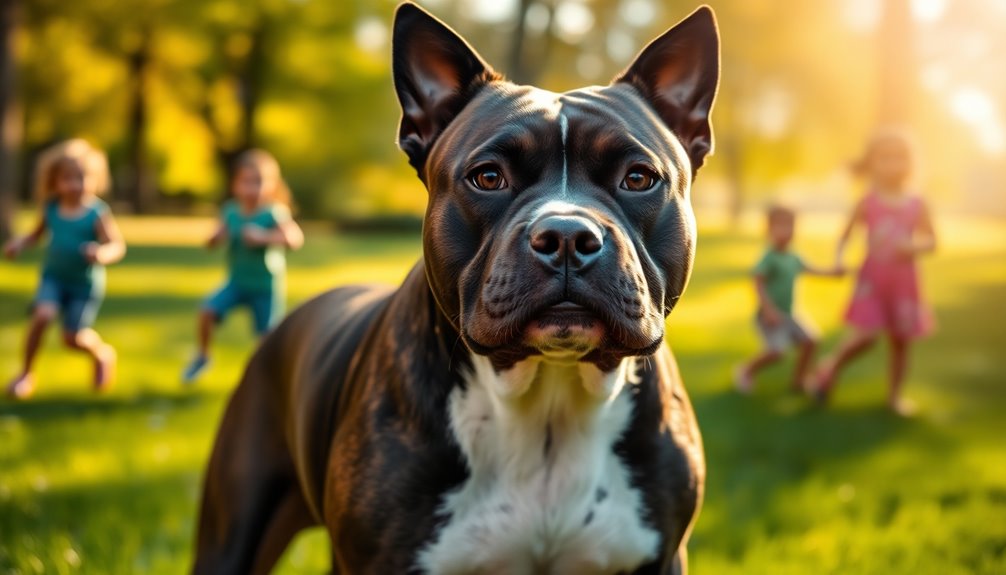
When you think about strength in dogs, the Staffordshire Bull Terrier stands out for its impressive agility and muscular build relative to its size. You might even remember seeing one in 'Lady and the Tramp', showcasing their lively nature. This breed combines power and grace, making them one of the strongest dogs in their weight class. Their muscular, stocky build contributes to their remarkable strength, allowing them to excel in various physical activities.
Remarkable Agility for Their Size
Exhibiting remarkable agility for their size, Staffordshire Bull Terriers are often underestimated due to their medium stature. You'll find that these dogs can start agility training as early as 12-18 months, with foundation workshops beginning at just 6 months. They shine in various agility disciplines, mastering jumps, tunnels, and weave poles, thanks to their muscular and athletic build. Their strong physique, a result of their history as agile fighting dogs, allows them to navigate agility equipment with impressive ease. Despite their size, Staffords compete successfully against larger breeds, often achieving high grades and even gold warrants in agility competitions. They've qualified for prestigious events, including the Olympia semi-finals, showcasing their versatility and skill. Many Staffordshire Bull Terriers, like Stella and Boson, exemplify the adaptability and eagerness to please seen in rescue dogs. To help your Stafford excel, early socialization and consistent training are essential. Positive reinforcement will keep them focused and eager to learn.
Featured in 'Lady and the Tramp
In the beloved classic "Lady and the Tramp," the Staffordshire Bull Terrier stands out as one of the strongest dogs for its size. At just 14 to 16 inches tall and weighing between 24 to 38 pounds, this breed packs an impressive muscular and stocky build.
You'll notice its broad chest and strong shoulders, which contribute to its reputation as a tough dog despite its compact stature.
While the Staffordshire Bull Terrier is known for its playful and affectionate nature towards family, it can also be exuberant, sometimes leading to rough play. With its historical significance tied to British working-class culture, it has transitioned to being a beloved family pet that embodies loyalty.
With proper training and socialization, it generally remains friendly toward strangers. However, be cautious; this breed has a historical background in dog fighting and may exhibit aggressive tendencies toward other dogs.
Your Staffordshire Bull Terrier will thrive with regular exercise and mental stimulation, needing both indoor and outdoor activities.
Its short coat requires minimal grooming, but it craves close human contact.
Remember, this spirited breed might challenge commands they disagree with, so patience and consistency are key to a harmonious relationship.
Active Lifestyle Compatibility
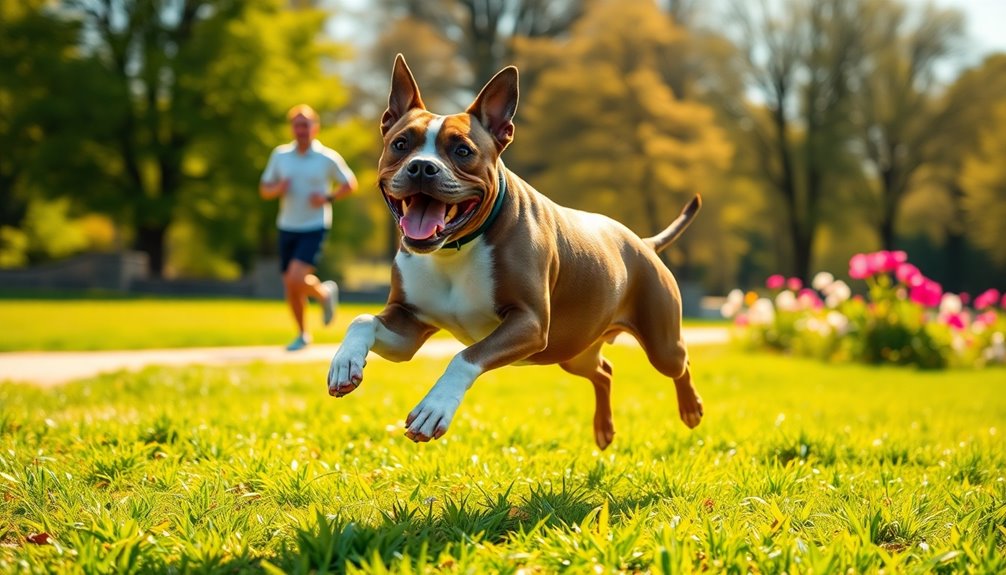
If you lead an active lifestyle, a Staffordshire Bull Terrier could be the perfect companion for you and your family.
These dogs thrive in dynamic environments and require plenty of socialization to stay happy and healthy. Energetic and playful, they enjoy engaging in various activities with their owners, making them great partners for outdoor adventures.
You'll need to commit to regular exercise and engaging activities to meet their energetic needs and enhance their social skills.
Ideal for Active Families
How well does your family enjoy outdoor adventures? If your family thrives on activity, a Staffordshire Bull Terrier could be the perfect fit. This energetic breed requires a minimum of 1-2 hours of exercise each day, making them ideal companions for hikes, beach trips, or games of fetch.
They love to play, and you'll find that mixing physical activities with mental challenges, like puzzle toys and scent games, keeps them engaged and happy. Staffies adapt well to active families and bond closely with all members, including kids. Known for their affectionate and gentle nature, they are often described as the "nanny dog" due to their compatibility with children.
They thrive in environments where they can join in on multiple walks and play sessions. However, make sure you have a secure, Staffie-proofed garden to prevent any escape attempts, as their adventurous spirit might lead them to explore.
Even if you live in an apartment, as long as you commit to regular outdoor exercise and mental stimulation, your Staffie will be content. Just remember, they need companionship and don't handle long periods alone very well.
Providing consistent playtime and interaction is essential for their happiness, making them a great addition to any active family lifestyle.
Socialization Needs and Challenges
During the critical developmental period of 3 to 14 weeks, socialization plays a vital role in shaping a Staffordshire Bull Terrier's behavior and temperament. Early exposure to various people, dogs, environments, and experiences is essential for developing a well-adjusted and friendly dog. If you don't provide this exposure, your pup may develop fear, anxiety, or reactivity as an adult.
To ensure successful socialization, start as early as possible. Take your puppy to parks, puppy classes, and arrange playdates, using positive reinforcement techniques like treats and praise to encourage desired behaviors. Gradually introduce your dog to new stimuli, paying close attention to their body language. Additionally, their affectionate and loyal nature makes them more receptive to positive interactions with people and other pets. Proper nutrition is also important during this stage, as it supports their cognitive development and emotional well-being.
It's also crucial to maintain ongoing socialization throughout their life, especially if you lead an active lifestyle. Regular exercise—at least 60-90 minutes daily—keeps your Staffordshire Bull Terrier happy and mentally stimulated.
Incorporate various activities, from walks and runs to interactive play and puzzle toys, to meet their physical and mental needs. By doing this, you'll not only enhance their social skills but also ensure they remain adaptable and well-behaved in diverse situations.
Frequently Asked Questions
Are Staffordshire Bull Terriers Good With Children and Other Pets?
Yes, Staffordshire Bull Terriers can be great with children and other pets.
They're known for their affectionate and gentle nature, often acting as protective companions. However, you should supervise their interactions, especially with young kids, to ensure safety.
When it comes to other animals, proper training and socialization are key. If raised together, they can form strong bonds, but it's essential to ensure compatibility and manage introductions carefully.
How Much Exercise Do Staffordshire Bull Terriers Need Daily?
Staffordshire Bull Terriers need about 1 to 2 hours of exercise each day.
It's best to spread this time out with at least two walks, plus additional playtime to keep them happy and healthy.
You can engage them in activities like brisk walking, running, or games like fetch and tug-of-war.
Do Staffordshire Bull Terriers Shed a Lot?
No, Staffordshire Bull Terriers don't shed a lot. Their shedding levels are low to moderate, scoring a 5 out of 10.
You'll notice some shedding year-round, but it might increase slightly in autumn and spring. Adult dogs shed more than puppies, especially during the transition to their adult coat.
Regular brushing and proper grooming can help you manage any shedding and keep your home tidy while caring for your furry friend.
What Is the Average Lifespan of a Staffordshire Bull Terrier?
The average lifespan of a Staffordshire Bull Terrier typically ranges from 12 to 14 years, though individual health can impact this.
Factors like genetics, diet, exercise, and overall care play significant roles in determining how long your dog may live.
Regular vet check-ups and a balanced diet can help you reach the upper end of this range.
Some may even live beyond 14 years, while others might only reach 9 years.
How Can I Find a Reputable Staffordshire Bull Terrier Breeder?
To find a reputable Staffordshire Bull Terrier breeder, start by looking for those recognized by reputable organizations like the AKC.
Check their memberships in breed-specific clubs and certifications that emphasize good breeding practices.
Ensure they conduct health screenings for genetic issues and provide proper care for their dogs.
Also, verify their commitment to ongoing support post-sale and that they follow ethical breeding practices to ensure the health and well-being of their puppies.
Conclusion
In summary, Staffordshire Bull Terriers are not just strong and courageous; they're also incredibly affectionate companions. With their unique blend of loyalty and playfulness, they thrive in active households where they can engage with their humans. By understanding their history and needs, you can ensure a happy, healthy life for your furry friend. If you're ready for a loving and spirited addition to your family, a Staffy might just be the perfect match for you!

